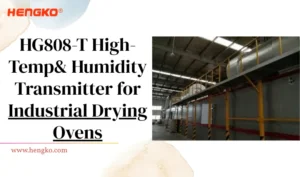
HG808-T High-Temperature Humidity Transmitter for Industrial Drying Ovens
HG808-T High-Temperature Humidity Transmitter for Industrial Drying Ovens In many manufacturing processes, drying is more
Apró cseppek, nagy hatás: Hogyan alakítják a harmatpont-jeladók a világotokat?
Home " Harmatpont jeladó
Fedezze fel a legfontosabb tényezőket, amelyeket figyelembe kell venni az optimális harmatponti hőmérséklet- és páratartalom-jeladó kiválasztásakor a HENGKO megbízható, pontos környezeti monitorozásához a különböző alkalmazásokban.
Check Dew Point Sensor / Transmitter Selection Guide First
| Modell | By Application Condition | Fő jellemzők |
| 1. Inline Dew Point Transmitter (Small HG602 Series ) | ||
Standard Precision Dew Point Measurement Dew Point Range: -60 … +60°C | - ±2 °C (±3.6℉)Td Accuracy (Dew Point) | |
| HG602-G (new) | Acidic / Corrosive Gas Environment Dew Point Monitoring Dew Point Range: -60 … +20°C | – ±3 °C (±5.4℉)Td Accuracy (Dew Point) – 316L stainless steel + anti-corrosion coating – Oil, salt spray & acid resistant (IP65 housing) – Suitable for HF, Cl₂, NH₃ and organic vapor applications |
Cold and Dry Environment Dew Point Measurement Dew Point Range: -30 … +50°C | - ±1℃ (±3.6℉) Td Accuracy (Dew Point) | |
| 2. Box Type Dew Point Transmitter ( HG808 Series ) | ||
| HG808-D | Normal Temperature Environment Dew Point Measurement Dew Point Range: -60 … +90°C | – Dew Point Accuracy: ±2℃ (±5.4℉) Td |
Chemical / Acidic / Solvent Gas Monitoring Dew Point Range: -60 … +20°C | – Dew Point Accuracy: ±3℃ (±5.4℉) Td | |
| HG808-A | Ultra High Temperature Moisture-Sensitive Applications + Dew Point Measurement Dew Point Range: -20 … +100°C | – Dew Point Accuracy: ±3℃ (±5.4℉) Td – Operates +80 °C to +180 °C (200 °C Short-lived) – 316L stainless steel sensor housing – Fast response & long-term stability under heat stress |
HG602 Series
Az Inline harmatpontérzékelő egy innovatív eszköz, amelyet úgy terveztek, hogy zökkenőmentesen integrálható legyen a különböző ipari és kereskedelmi rendszerekbe.
HG808 Series
A HENGKO a hőmérséklet- és páratartalom harmatpont érzékelők széles választékát kínálja számos alkalmazáshoz.
A HENGKO az ipari hőmérséklet- és páratartalom-érzékelők széles skáláját kínálja, amelyek alkalmasak a különböző felügyeleti igények kielégítésére, a következőktől függően rozsdamentes acél érzékelő szondák a címre. harmatpont jeladók és a következő 6 féle hőmérséklet- és páratartalom-mérő eszköz megoldás. Arra összpontosítunk, hogy pontos, megbízható és hosszú élettartamú érzékelőket biztosítsunk, így azok tökéletesek a legkülönbözőbb alkalmazásokhoz.
HG970 sorozat
A kézi harmatpontmérő egy kompakt, hordozható készülék, amelyet a páratartalom pontos és kényelmes mérésére terveztek különböző környezetekben.
A HENGKO az ipari érzékelő megoldások globális vezetője, amely az egyedi tervezés és a kiváló teljesítmény hírnevét öregbíti. Hőmérséklet- és páratartalom-jeladóinkat és érzékelőinket az iparágak széles körében használják, beleértve az élelmiszer- és italgyártást, a gyógyszeripart, a feldolgozóipart és a környezetfelügyeletet.
Szabadalmaztatott és saját tervezésű harmatpont-jeladó sorozatunk alapján teljesen testre szabhatja egyedi harmatpont-érzékelő termékét.
Rendkívül költséghatékony ellenőrzésünknek köszönhetően sokkal alacsonyabb és versenyképes árat kap.
Folyamatosan frissülő termékeinkkel mindig megfelel a folyamatosan változó piaci igényeknek.
Erős marketing támogatást kap, hogy segítsen a termékek sikeres eladásában, az anyagi támogatások közé tartoznak: nagy felbontású termékképek, menő 3d hatású videók, és még sok más.










Harmatpont érzékelő a sűrített levegő rendszer monitor : Optimális páratartalom-szabályozás és levegőminőség biztosítása a légsűrítő gép számára
A HENGKO a professzionális harmatpont-transzmitterek, hőmérséklet- és páratartalom-transzmitterek, valamint kézi harmatpontmérők vezető gyártója. A hőmérséklet- és páratartalom-monitorozási megoldások széles választékát kínáljuk az Ön egyedi igényeinek megfelelően.
Termékeinket pontosságra és megbízhatóságra terveztük, optimális teljesítményt biztosítva a különböző alkalmazásokban. Akár kiváló minőségű harmatpont-érzékelőre, akár robusztus páratartalom-jeladóra van szüksége, a HENGKO rendelkezik a szakértelemmel és a termékekkel, hogy támogassa projektjét.
Vegye fel velünk még ma a kapcsolatot, hogy megvitassuk az igényeit, és felfedezzük a legjobb megoldásokat az Ön felügyeleti igényeihez.






A harmatpont az a hőmérséklet, amelyre a levegőt le kell hűteni ahhoz, hogy vízgőzzel telítődjön. Más szóval, ez az a hőmérséklet, amelyen a levegő már nem képes több vízgőzt gáz formájában megtartani. Ha a levegőt tovább hűtjük, a felesleges vízgőz folyékony vízzé kondenzálódik, harmatot képezve.
A harmatpont fontos meteorológiai paraméter, mert a harmatpont a levegő hőmérsékletének a levegő nedvességtartalma. Minél magasabb a harmatpont, annál több nedvességet tartalmaz a levegő. Ez a levegőt párássá vagy kellemetlenné teheti, különösen egy forró napon.
A harmatpontot arra is használják, hogy a köd és a harmat kialakulásának előrejelzése. Ha a harmatpont közel van a levegő hőmérsékletéhez, akkor valószínűleg köd vagy harmat képződik. Ez azért van így, mert a levegő közel van ahhoz, hogy telítetté váljon, és minden további lehűlés a vízgőz kondenzációját eredményezi.
Itt van egy táblázat általános komfortérzet a harmatpont használatával:
| Harmatpont (°F) | Kényelmi szint |
|---|---|
| 50 alatt | Kényelmes |
| 50-60 | Kissé fülledt |
| 60-65 | Muggy |
| 65-70 | Nagyon fülledt |
| 70 felett | Elnyomó |
Amint láthatja, a harmatpont jó mutatója annak, hogy mennyire lesz kellemes a levegő. Ha azt tervezi, hogy a szabadban tartózkodik, érdemes ellenőrizni a harmatpont-előrejelzést, mielőtt elindul.
Íme a harmatpontjeladók néhány fő jellemzője:
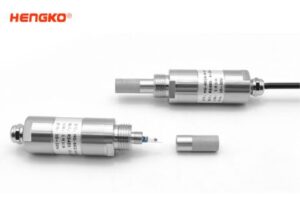
E fő jellemzőkön kívül a harmatpontjeladók számos más funkciót is kínálhatnak, például:
A harmatpontjeladók értékes eszközök a nedvességtartalom mérésére és ellenőrzésére számos alkalmazásban. Pontosak, megbízhatóak és sokoldalúak, és felhasználhatók a termékek minőségének javítására, a berendezések védelmére és az ipari folyamatok optimalizálására.
A harmatpontjeladóknak három fő típusa van: hűtött tükör, polimer és fém-oxid.
Hűtött tükör
A hűtött tükrös harmatpontjeladók a legpontosabb típusú harmatpontjeladók. Úgy működnek, hogy egy tükröt hűtenek, amíg a vízgőz le nem kondenzálódik a felületén. Ezután a tükör hőmérsékletét mérik, és ez a hőmérséklet a harmatpont. A hűtött tükrös harmatpontjeladók jellemzően olyan alkalmazásokban használatosak, ahol nagy pontosságra van szükség, például a gyógyszeriparban és a félvezetőiparban.
Polimer
A polimer harmatpontjeladók kevésbé pontosak, mint a hűtött tükrös harmatpontjeladók, de olcsóbbak is. Működésük során a polimer érzékelő elektromos ellenállásának változását mérik a nedvességtartalom változásával. A polimer harmatpontjeladók jellemzően olyan alkalmazásokban használatosak, ahol a költség fontos szempont, például a HVAC-iparban.
Fém-oxid
A fém-oxid harmatpontjeladók hasonlóak a polimer harmatpontjeladókhoz, de más típusú érzékelőt használnak. A fém-oxid harmatpontjeladók jellemzően olyan alkalmazásokban használatosak, ahol széles mérési tartományra van szükség, például az élelmiszer- és italiparban.
Az alábbi táblázatban összehasonlítjuk a harmatpontjeladók három fő típusát:
| Jellemző | Hűtött tükör | Polimer | Fém-oxid |
|---|---|---|---|
| Pontosság | Magas | Közepes | Közepes |
| Költségek | Magas | Alacsony | Közepes |
| Mérési tartomány | Széles | Keskeny | Széles |
| Válaszidő | Lassú | Gyors | Közepes |
| Karbantartás | Magas | Alacsony | Közepes |
| Alkalmazások | Gyógyszeripar, félvezetők | HVAC | Élelmiszerek és italok |
Az adott alkalmazáshoz legmegfelelőbb harmatpontjeladó típusa az alkalmazás egyedi követelményeitől függ. Általában a hűtőtükrös harmatpontjeladók a legjobb választás olyan alkalmazásokhoz, ahol nagy pontosságra van szükség. A polimer harmatpontjeladók jó választásnak bizonyulnak olyan alkalmazásokhoz, ahol a költség a fő szempont. A fém-oxid harmatpontjeladók jó választásnak bizonyulnak olyan alkalmazásokhoz, ahol széles mérési tartományra van szükség.
A harmatpontjeladók számos alkalmazásban fontosak, többek között:
HVAC-rendszerek: A harmatpont-jeladók a HVAC-rendszerekben a páratartalom szabályozására szolgálnak. A páratartalom fontos az emberi kényelem és egészség szempontjából. A túl magas páratartalom miatt a levegő fülledtnek és kellemetlennek érezhető, és penészgombák kialakulásához is vezethet. A túl alacsony páratartalom miatt a levegő száraznak tűnhet, és légzőszervi problémákhoz is vezethet.
Ipari folyamatirányítás: A harmatpont-jeladók az ipari folyamatszabályozásban használatosak annak biztosítására, hogy a termékek előállítása megfelelő páratartalom mellett történjen. A páratartalom számos termék, például a gyógyszerek, a félvezetők, valamint az élelmiszerek és italok minőségét befolyásolhatja.
Környezetvédelmi monitoring: A harmatpont-jeladók a környezeti megfigyelésben a légkör nedvességtartalmának változását követik nyomon. Ez az információ felhasználható az időjárási viszonyok előrejelzésére és a lehetséges környezeti problémák azonosítására.
Íme néhány konkrét példa arra, hogyan használják a harmatpontmérőket a különböző iparágakban:
Gyógyszeripar: A harmatpontjeladók a páratartalom szabályozására szolgálnak a tiszta helyiségekben, ahol gyógyszereket gyártanak. A páratartalom szintjét gondosan szabályozni kell a gyógyszerek lebomlásának megakadályozása és a legmagasabb minőségi szabványoknak megfelelő gyártás biztosítása érdekében.
Félvezetőipar: A harmatpontjeladók a félvezetőgyártó üzemekben a páratartalom ellenőrzésére szolgálnak. A páratartalom szintjét gondosan szabályozni kell, hogy megelőzzék az ostyák szennyeződését, és biztosítsák, hogy a félvezetők a legmagasabb minőségi szabványoknak megfelelően készüljenek.
Élelmiszer- és italipar: A harmatpontjeladók az élelmiszer- és italgyártó létesítményekben a páratartalom ellenőrzésére szolgálnak. A páratartalom szintjét gondosan szabályozni kell a penész és a penészgomba kialakulásának megelőzése, a termékek megfelelő állagának biztosítása és a termékek eltarthatósági idejének meghosszabbítása érdekében.
HVAC-ipar: A harmatpont-jeladók a HVAC-rendszerekben a lakások, irodák és egyéb épületek páratartalmának szabályozására szolgálnak. A páratartalom szintjét gondosan szabályozni kell az emberi kényelem és egészség biztosítása érdekében.
Környezetvédelmi monitoring: A harmatpontjeladók a környezeti megfigyelő állomásokon a légkör nedvességtartalmának változását követik nyomon. Ez az információ felhasználható az időjárási viszonyok előrejelzésére és a lehetséges környezeti problémák, például az aszály vagy az árvíz azonosítására.
Amint láthatja, a harmatpontjeladók számos alkalmazásban fontosak. Elengedhetetlenek a termékek minőségének biztosításához, a berendezések védelméhez és az ipari folyamatok optimalizálásához.
A fent felsorolt előnyök mellett a harmatpontjeladók a következőkben is segíthetnek:
A megfelelő harmatpontjeladó kiválasztása a sűrítettlevegő-rendszerhez elengedhetetlen a hatékony működés fenntartásához és a termékek minőségének biztosításához. Íme egy átfogó útmutató az Ön egyedi igényeihez legmegfelelőbb harmatponti jeladó kiválasztásához:
Határozza meg a szükséges pontosságot: Vegye figyelembe az alkalmazás pontossági követelményeit. Ha pontos harmatpontmérésre van szüksége, a legpontosabb megoldás a hűtött tükrös harmatpontmérő. Ha azonban a költség az elsődleges szempont, elegendő lehet egy polimer vagy fémoxid harmatpontjeladó.
Értékelje a mérési tartományt: Mérje fel a mérendő harmatpont-tartományt. A sűrített levegős rendszerek általában egy meghatározott harmatpont-tartományban működnek, ezért győződjön meg arról, hogy a jeladó hatékonyan le tudja fedni ezt a tartományt.
Vegye figyelembe a válaszidőt és a karbantartást: A reakcióidő alapvető fontosságú a harmatpont változásainak gyors észleléséhez. Ha a valós idejű felügyelet kritikus, válasszon gyors válaszidejű jeladót. A karbantartási követelmények is eltérőek a különböző típusoknál. A hűtött tükör adók több karbantartást igényelnek, míg a polimer és fémoxid adók általában alacsony karbantartási igényűek.
Válassza ki a megfelelő kimeneti beállításokat: Döntse el, hogy milyen kimeneti lehetőségekre van szüksége a rendszerrel való integrációhoz. Az általános kimeneti lehetőségek közé tartoznak az analóg (4-20 mA vagy 0-10 V), a digitális (RS-485 vagy Modbus) és a riasztási relék.
Környezeti megfontolások: Értékelje a környezeti körülményeket, ahol a jeladót telepíteni fogják. Válasszon olyan jeladót, amely ellenáll a várható hőmérsékletnek, páratartalomnak és rezgésszintnek.
További jellemzők: Vegye fontolóra a további előnyös funkciókat, például az adatnaplózást, a riasztási beállítási pontokat és a távoli hozzáférési lehetőségeket. Ezek a funkciók javíthatják a felügyeleti és vezérlési képességeket.
Konzultáljon szakértőkkel: Ha összetett követelményei vannak, vagy segítségre van szüksége a legmegfelelőbb harmatpontjeladó kiválasztásához, forduljon a terület tapasztalt szakembereihez. Ők személyre szabott ajánlásokat tudnak adni az Ön egyedi alkalmazása és igényei alapján.
Íme egy összefoglaló táblázat, amely segít a kiválasztásban:
| Jellemző | Hűtött tükör | Polimer | Fém-oxid |
|---|---|---|---|
| Pontosság | Magas | Közepes | Közepes |
| Költségek | Magas | Alacsony | Közepes |
| Mérési tartomány | Széles | Keskeny | Széles |
| Válaszidő | Lassú | Gyors | Közepes |
| Karbantartás | Magas | Alacsony | Közepes |
| Alkalmazások | Gyógyszeripar, félvezetők | HVAC | Élelmiszerek és italok |
| Kimeneti lehetőségek | Analóg, digitális, riasztási relék | Analóg, digitális | Analóg, digitális |
| További jellemzők | Adatrögzítés, riasztási beállítások, távoli hozzáférés | Korlátozott | Korlátozott |
A 4-20mA kimenet népszerű választás a harmatpontérzékelőkhöz, mivel ez egy szabványos ipari kimenet, amely a vezérlőrendszerek széles körével kompatibilis. Emellett nagyon megbízható és zajálló kimenet, ami alkalmassá teszi a zord ipari környezetben való használatra.
Íme néhány előnye a 4-20mA kimenet használatának a harmatpontérzékelők esetében:
Kompatibilitás: A 4-20mA kimenet a vezérlőrendszerek széles skálájával kompatibilis, beleértve a PLC-ket, DCS-eket és SCADA-rendszereket. Ez megkönnyíti a harmatpontérzékelők integrálását a meglévő vezérlőrendszerekbe.
Megbízhatóság: A 4-20mA kimenet egy nagyon megbízható kimenet, amely nem érzékeny a zavaró zajokra. Ez fontos a harmatpontérzékelők esetében, amelyeket gyakran használnak zord ipari környezetben.
Pontosság: A 4-20mA kimenet pontos harmatpontmérést biztosít. Ez olyan alkalmazásoknál fontos, ahol pontos harmatpont-szabályozásra van szükség.
Hatótávolság: A 4-20mA kimenet a harmatpontértékek széles tartományát képes lefedni. Ezáltal számos alkalmazáshoz alkalmas.
Költségek: A 4-20mA kimenet egy viszonylag olcsón megvalósítható kimenet. Ez teszi költséghatékony megoldássá a harmatpontérzékelők számára.
A fent felsorolt előnyök mellett a 4-20mA kimenet egy nagyon sokoldalú kimenet. Számos más paraméter, például hőmérséklet, nyomás és áramlási sebesség továbbítására is használható. Ezáltal az ipari alkalmazások széles skáláján értékes kimenetet jelent.
Íme néhány példa azokra az alkalmazásokra, ahol a 4-20mA kimenettel rendelkező harmatpontérzékelőket általában használják:
Sűrített levegős rendszerek: A harmatpontérzékelőket sűrítettlevegő-rendszerekben a levegő nedvességtartalmának ellenőrzésére és szabályozására használják. Ez fontos a berendezések korróziójának és egyéb károsodásának megelőzése szempontjából.
HVAC-rendszerek: A harmatpontérzékelőket a HVAC-rendszerekben használják az épületek páratartalmának szabályozására. Ez fontos az emberi kényelem és egészség szempontjából.
Ipari szárítási eljárások: A harmatpontérzékelőket ipari szárítási folyamatokban használják a szárítandó termék nedvességtartalmának ellenőrzésére és szabályozására. Ez fontos a termék minőségének biztosítása szempontjából.
Élelmiszer- és italfeldolgozás: A harmatpontérzékelőket az élelmiszer- és italfeldolgozásban használják a feldolgozott termék nedvességtartalmának ellenőrzésére. Ez fontos a termék biztonságának és minőségének biztosítása érdekében.
Környezetvédelmi monitoring: A harmatpontérzékelőket a környezeti megfigyelő állomásokon használják a légkör nedvességtartalmának változásainak nyomon követésére. Ez az információ felhasználható az időjárási viszonyok előrejelzésére és a lehetséges környezeti problémák azonosítására.
Mint látható, a 4-20mA kimenettel rendelkező harmatpontérzékelők értékes eszközök az ipari alkalmazások széles skáláján. Megbízhatóak, pontosak és sokoldalúak, és könnyen integrálhatók a meglévő vezérlőrendszerekbe.
A harmatpontjeladók ára a gyártótól, a jellemzőktől és a jeladó pontosságától függően változhat. Általában a nagyobb pontosságú és több funkcióval rendelkező harmatpontjeladók többe kerülnek, mint a kisebb pontosságú és kevesebb funkcióval rendelkező harmatpontjeladók.
Kutatásaim alapján azt mondanám, hogy a harmatpontjeladók ára általában tisztességes. A harmatpont-transzmitterek gyártásához szükséges alkatrészek és a munkaerő költségei magasak, és a harmatpont-transzmittereket gyártó vállalatoknak meg kell térülniük ezeknek a költségeknek, hogy az üzletben maradhassanak. Ezenkívül a harmatpontjeladók számos kritikus alkalmazásban használatosak, ezért fontos, hogy megbízhatóak és pontosak legyenek. A harmatpont-transzmitterek magas ára azt a tényt tükrözi, hogy kiváló minőségű műszerekről van szó, amelyek megbízhatóan pontos méréseket biztosítanak.
Íme néhány tényező, amely befolyásolhatja a harmatpontjeladó árát:
Az alábbi táblázat a piacon kapható harmatpontjeladók árkategóriáját mutatja be:
| Típus | Ártartomány |
|---|---|
| Hűtött tükör | $2,000 – $10,000 |
| Polimer | $500 – $2,000 |
| Fém-oxid | $500 – $1,500 |
Mint látható, a harmatpontjeladók árkategóriája a jeladó típusától függően változhat. A hűtött tükrös harmatpontjeladók a legdrágább típusú jeladók, de ezek a legpontosabbak is. A polimer és fémoxid harmatpontjeladók olcsóbbak, de kevésbé pontosak is.
A harmatpontjeladók ára a jeladó jellemzőitől függően is változhat. Például az adatnaplózási, riasztási beállítási és távoli hozzáférési lehetőséggel rendelkező harmatpontjeladók általában többe kerülnek, mint a kevesebb funkcióval rendelkező harmatpontjeladók.
Ha kiváló minőségű harmatpontjeladót keres, akkor azt javasolnám, hogy olyan jól ismert márkától vásároljon, amely jó hírnévnek örvend a minőség és a megbízhatóság terén. Azt is figyelembe kell vennie, hogy milyen funkciók fontosak az Ön számára, és milyen pontosságra van szüksége. Ha nem biztos abban, hogy melyik harmatpontmérő a megfelelő az Ön számára, javaslom, hogy konzultáljon egy szakemberrel, aki segíthet a megalapozott döntés meghozatalában.
néhány kérdés a harmatpontról és a jeladóról és érzékelőről, amit Ön és az emberek szeretnének tudni
A magas harmatpont azt jelenti, hogy a levegő sok nedvességet képes megtartani, mielőtt telítődne és kondenzáció lépne fel. Általában a 15 °C (60 °F) feletti harmatpont magasnak számít. A magas harmatpont miatt a levegő párás és kellemetlen érzést kelthet, különösen egy forró napon.
Valójában két fő típusa van a harmatpontjeladóknak, mindegyiknek más-más működési elve van, kérjük, ellenőrizze a következőket:
1. Hűtött tükörrel működő harmatpontjeladók:
2. Polimer/kerámia érzékelős harmatpontjeladók:
Melyik típus a jobb?
A hűtőtükör és a polimer/kerámia érzékelős jeladó közötti választás az Ön egyedi igényeitől függ:
Remélem, ez a magyarázat segít!
Kérdezzen bátran, vagy lépjen kapcsolatba csapatunkkal a következő címen e-mail ha további kérdései vannak a harmatpontjeladókkal kapcsolatban.
A harmatpont és a páratartalom a levegőben lévő nedvesség mennyiségének két különböző mérőszáma.
1.Harmatpont az a hőmérséklet, amelyre a levegőt le kell hűteni ahhoz, hogy vízgőzzel telítetté váljon. Más szóval, ez az a hőmérséklet, amelyen a levegő már nem képes több vízgőzt gáz formájában megtartani. Ha a levegőt tovább hűtjük, a felesleges vízgőz folyékony vízzé kondenzálódik, harmatot képezve.
2.Humiditymásrészt a levegőben lévő vízgőz mennyisége, a levegő által befogadható maximális vízgőzmennyiség százalékában kifejezve. A relatív páratartalom a páratartalom legelterjedtebb mértékegysége, és úgy számítják ki, hogy a levegőben lévő vízgőz tényleges mennyiségét elosztják a levegő által adott hőmérsékleten megtartható maximális vízgőzmennyiséggel.
A harmatpont-hőmérséklet kiszámításának többféle módja van. A legelterjedtebb módszer a higrométer használata, amely egy olyan eszköz, amely a hőmérsékletet és a páratartalmat is méri. A harmatponti hőmérsékletet ezután a hőmérséklet- és páratartalom-mérésekből egy speciális képlet segítségével lehet kiszámítani.
A harmatponti hőmérséklet kiszámításának másik módja a pszichrométer használata, amely egy olyan eszköz, amely két hőmérőből áll, egy nedves és egy száraz hőmérsékletű hőmérőből. A harmatponti hőmérsékletet ezután a nedves és a száraz hőmérséklet különbségéből lehet kiszámítani egy speciális táblázat vagy képlet segítségével.
Nem, a harmatpont és a páratartalom nem ugyanaz. A harmatpont a levegőben lévő nedvesség mennyiségét méri, míg a páratartalom a levegőben lévő vízgőz mennyiségének és a levegő által befogadható maximális vízgőzmennyiségnek az aránya.
Két különböző légtömegnek lehet azonos harmatpontja, de eltérő páratartalomszintje. Például egy magas harmatpontú meleg légtömegnek és egy alacsony harmatpontú hűvös légtömegnek is lehet azonos a páratartalma. Ez azért van így, mert a meleg légtömeg több vízgőzt képes megtartani, mint a hűvös légtömeg.
A Mountain Dew-ban nincs tőkehalpont. A tőkehalpont egy mértékegység, amelyet a termékben lévő tőkehalmájolaj mennyiségének számszerűsítésére használnak. A Mountain Dew nem tartalmaz csukamájolajat.
A legtöbb ember számára a kellemes harmatpont-tartomány 4 °C (40 °F) és 15 °C (60 °F) között van. 40°F alatt a levegő száraznak és kellemetlennek érezhető. 60°F felett a levegő párás és kellemetlen lehet.
A 15 °C (60 °F) feletti harmatpont párásnak minősül. A párás levegő ragacsos és kellemetlen érzés, különösen egy forró napon.
A 18 °C (65 °F) feletti harmatpontot párásságnak tekintjük. A párás levegő még ragacsosabb és kellemetlenebb érzés, mint a párás levegő.
A harmatpontmérők, más néven harmatpontjeladók vagy -érzékelők számos célra szolgálnak a különböző területeken. Íme néhány a leggyakoribbak közül:
1. A légköri viszonyok megfigyelése:
2. A páratartalom szabályozása:
3. A berendezések és anyagok védelme:
4. Kutatási és tudományos alkalmazások:
Összességében a harmatpontmérők hihetetlenül sokoldalú eszközök, amelyeket különböző területeken használnak a páratartalom megértésére és kezelésére, biztosítva a biztonságot, a hatékonyságot és a minőséget a különböző alkalmazásokban.
A légpalackban lévő páratartalom vizsgálata kulcsfontosságú a benne lévő sűrített levegő minőségének és teljesítményének biztosítása érdekében. A túlzott nedvesség korrózióhoz, csökkent áramláshoz és a levegőt használó berendezések meghibásodásához vezethet. Az alábbiakban két gyakori módszert mutatunk be a légpalackban lévő páratartalom vizsgálatára:
1. Hűtött tükör higrométer:
2. Higroszkópos érzékelő:
További tippek:
Így az alábbi módszerek és tippek segítségével hatékonyan ellenőrizheti a légpalackban lévő páratartalmat, és biztosíthatja a berendezés optimális teljesítményét.
A sűrített levegő harmatpontjának szabályozása kulcsfontosságú a pneumatikus berendezések minőségének és teljesítményének biztosításához. A túlzott nedvesség korrózióhoz, az áramlás csökkenéséhez, a berendezések hibás működéséhez, sőt az érzékeny termékek szennyeződéséhez is vezethet. Íme néhány kulcsfontosságú módszer a sűrített levegő harmatpontjának szabályozására:
1. Légszárítók:
A levegőszárítók a sűrített levegő nedvességének eltávolítására szolgáló legelterjedtebb és leghatékonyabb módszer. Úgy működnek, hogy csökkentik a harmatpontot, vagyis azt a hőmérsékletet, amelyen a vízgőz lecsapódik. A levegőszárítóknak két fő típusa van:
Hűtőanyag-szárítók: Ezek a szárítók hűtőrendszert használnak a sűrített levegő hűtésére, ami a vízgőz kondenzálódását és távozását okozza. Alkalmasak 4 °C (40 °F) körüli harmatpontok elérésére.
Szárítóanyag-szárítók: Ezek a szárítók szárítóanyagot, például szilikagélt vagy timföldet használnak a nedvesség sűrített levegőből történő elnyelésére. Sokkal alacsonyabb, akár -40 °F (-40 °C) vagy még alacsonyabb harmatpontokat is elérhetnek, így ideálisak kritikus alkalmazásokhoz.
2. Utóhűtők:
3. Lefolyócsapdák:
4. Rendszertervezés és karbantartás:
További tippek:
Ezen módszerek és tippek alkalmazásával hatékonyan szabályozhatja a sűrítettlevegő-rendszer harmatpontját, és biztosíthatja berendezései optimális teljesítményét és hosszú élettartamát.
A harmatpont-jeladók és -érzékelők döntő szerepet játszanak a nedvességtartalom szabályozásában a különböző iparágakban. Íme, a 10 legfontosabb alkalmazás, ahol ezek a műszerek ragyognak:
A száraz és tiszta sűrített levegő biztosítása létfontosságú a hatékony működéshez és a korrózió megelőzéséhez a pneumatikus berendezésekben. A harmatpont-jeladók figyelemmel kísérik a szárazságszinteket, optimalizálják a szárító teljesítményét és elkerülhetővé teszik a költséges problémákat.
A pontos harmatpont-szabályozás kritikus fontosságú a termékminőség és a konzisztencia szempontjából a vegyipari és gyógyszeripari gyártásban. A nedvesség pontos mérése és kezelése megelőzi a reakciókat, biztosítja a pontos receptúrákat és a termék stabilitását.
A harmatpont-szabályozás döntő fontosságú az élelmiszerek minősége és eltarthatósága szempontjából. A tárolási és feldolgozási környezet optimális nedvességszintjének figyelemmel kísérése és fenntartása megakadályozza a páralecsapódást, a penészesedés kialakulását és a termék romlását.
A harmatpont-érzékelők segítenek fenntartani a kényelmes páratartalmat az épületekben, és optimalizálják a hűtőrendszereket. A pontos harmatpontadatok lehetővé teszik a megfelelő légkondicionáló vezérlést, maximalizálják az energiahatékonyságot és megelőzik a kondenzációs problémákat.
A harmatpontmérések szerves részét képezik az időjárás-előrejelzésnek, az éghajlati tanulmányoknak és a mezőgazdasági alkalmazásoknak. A harmatpont-változások megfigyelése segít a fagy, a harmatképződés és más környezeti jelenségek előrejelzésében.
A harmatpont-szabályozás létfontosságú a repülőgépek biztonsága és teljesítménye szempontjából. A száraz levegő megakadályozza a jégképződést a kritikus alkatrészeken, biztosítva a légi alkalmasságot és a biztonságos üzemeltetést.
Az orvosi létesítményekben és biotechnológiai laboratóriumokban a pontos harmatpontszintek fenntartása elengedhetetlen a sterilitás és a káros mikroorganizmusok szaporodásának megakadályozása érdekében.
Az erőművek nedvességének szabályozása kulcsfontosságú a hatékony energiatermeléshez, valamint a turbinák és más berendezések korróziójának megelőzéséhez. A harmatpontmérés biztosítja az erőmű optimális működését és minimalizálja a karbantartási költségeket.
A harmatpont ellenőrzése az építkezés során segít megelőzni a páralecsapódási problémákat, a penészesedést és a szerkezeti károkat. A harmatpontadatok a megfelelő szellőztetési és szárítási stratégiákhoz nyújtanak információt, így biztosítva a tartós és egészséges épületeket.
A harmatpontérzékelők segítenek optimalizálni a festékkeményedési folyamatokat az autógyártásban, és megakadályozzák a kondenzáció kialakulását a lezárt járműalkatrészekben. Ez biztosítja a kiváló minőségű fényezést és véd a korrózió ellen.
A fentiek csak néhány példa, és harmatpont jeladók és érzékelőknek számos alkalmazása van ezen a tízen túl is.
Sokoldalúságuk és pontosságuk a nedvesség mérésében felbecsülhetetlen értékű eszközzé teszi őket a különböző iparágakban.
Van olyan konkrét alkalmazási területe, ahol szeretne többet megtudni a harmatpontjeladókról és -érzékelőkről?
Lépjen kapcsolatba a HENGKO-val ma a hőmérséklet- és páratartalom-érzékelő, a jeladó és a megoldás bármilyen kérdése esetén

HG808-T High-Temperature Humidity Transmitter for Industrial Drying Ovens In many manufacturing processes, drying is more
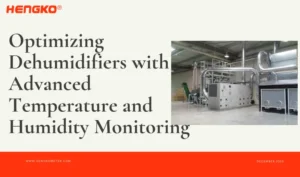
Effective moisture management is essential in facilities where materials, equipment, and processes depend on controlled
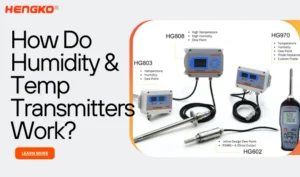
In short, Humidity and temperature transmitters measure and send environmental data to control systems. They
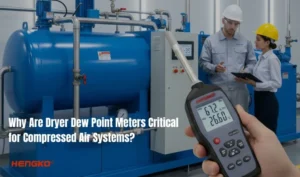
Why Are Dryer Dew Point Meters Critical for Compressed Air Systems? Maybe You always battle

Why One Office Zone is Too Humid & How a Humidity Transmitter Fixes It Persistent
Forduljon szakértői csapatunkhoz, hogy személyre szabott segítséget kapjon, és mi azonnal a legjobb hőmérséklet- és páratartalom-adó és érzékelő megoldásokat kínáljuk az Ön egyedi igényeihez igazítva.

HG808-T High-Temperature Humidity Transmitter for Industrial Drying Ovens In many manufacturing processes, drying is more than just a step — it’s a decisive factor that

HG808-T High-Temperature Humidity Transmitter for Industrial Drying Ovens In many
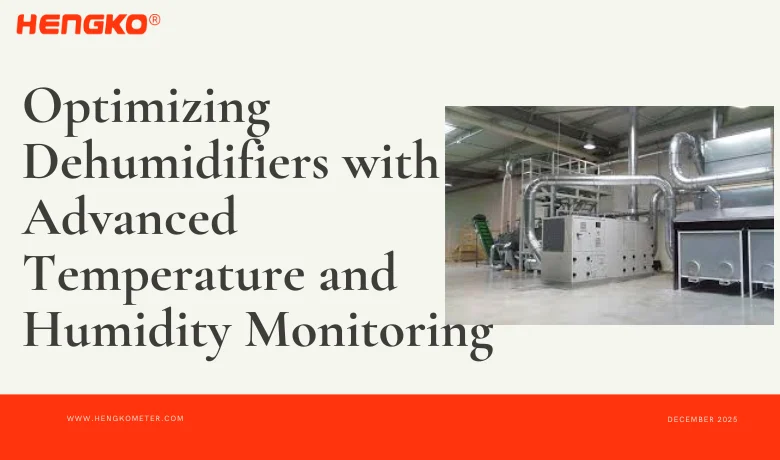
Effective moisture management is essential in facilities where materials, equipment,

In short, Humidity and temperature transmitters measure and send environmental
WhatsApp minket